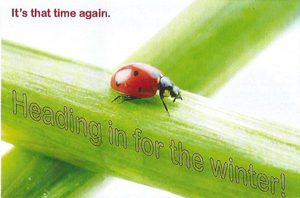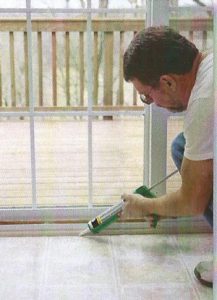Seasonal Invaders
Cluster flies
Cluster flies are common flies in homes during fall and early spring. Slightly larger than house flies, cluster flies are awkward, noisy fliers. They are attracted to lights and windows. They blunder into structures and fall to the floor, where they spin noisily on their backs only to recover and fly about again.
They are called cluster flies because they aggregate in attics, empty rooms, and closets. They enter buildings from the outside, apparently seeking warmth and shelter. Inactive in colder weather, cluster flies may suddenly reemerge on warm spring days. They don’t harm people or home furnishings. They are considered a nuisance.
Cluster flies are parasitic on earthworms. Females lay their eggs on the soil near earthworm burrows during the active season when they can be found only outside. The fly maggot isn’t associated with garbage or other kinds of food. Maggots feed inside an earthworm host for two to three weeks, after which they leave to pupate in the soil. Egg to adult development takes four to six weeks and they have two or three generations a year.
As temperatures drop in the fall and the earthworms needed to rear more flies go deeper into the soil, surviving adult cluster flies migrate inside. Wall voids, attics, or other areas of the home provide perfect shelter. They easily gain access through cracks and crevices. In more rural areas, they overwinter in barns, outside in tree holes, or around plant debris. Isolated homes in the country and suburbs may be especially inviting to hibernating cluster flies because these structures offer the best shelter around.
Wintertime cluster fly activity is temperature related. As the temperature increases, they wander from hibernation site to nearby surfaces. They show up on the south (warm) sides of homes, in windows that face the sun, or in response to heat in a house.
In early spring, adult flies feed on nectar in flowers or other sugar sources. They leave hibernation sites as the temperature warms and earthworms return to the soil surface.
Efforts to control cluster flies with applications of insecticides to lawns and gardens are not successful. Such materials may harm other organisms or the earthworms that are the food of the fly maggots. Differences in infestation from year to year may depend upon soil or weather conditions, especially as they effect soil moisture and the population of earthworm hosts.
Asian Ladybugs
Preventing Infestation
Late spring or summer is the best time to take action against infestation of the Lady Beetle by sealing cracks and openings around all windows, doors, soffits, fascia boards, utility pipes and wires, etc. with caulk or other suitable sealant.
Sealing cracks and openings is the most permanent way of preventing lady beetles from entering buildings.
Exterior Barrier Treatment
While sealing cracks and door openings is a more permanent way to limit beetle and other pests from entering, the approach is time-consuming and sometimes impractical. There can be countless cracks associated with eaves, siding, vents, etc. where insects can enter. On multi-story buildings, sealing becomes even more difficult.
Insecticides can be applied by a pest control company to building exteriors in the fall, which helps prevent pest entry. Fast-acting residual insecticides can be sprayed in a targeted band around windows, doors, eaves, soffits, attic vents and other likely points of entry.
Unfortunately, there is no “easy or quick fix” to annual lady beetle invasions. Vacuuming, pest proofing, and properly timed exterior insecticide treatments by a pest control professional can provide relief but will not prevent entry of every single beetle.
Box-elder Bugs
Probably the most common of the fall invading insects, this black and red marked bug actually feeds on trees, including the box elder and maple. It is a 1/2-inch long as an adult, and mostly black in color with red lines marking the wings and the thorax area behind the head.
Western Conifer Seed Bug
The western conifer seed bug, Leptoglossus occidentalis (Heteroptera:Coreidae), is becoming a nuisance pest to some New York residents. The bug has the habit of entering buildings at the onset of cold weather in the late summer or early fall as it seeks a protected site to spend the winter. These bugs do not bite or sting, nor do they cause damage to the home. They will, however, give off a pungent odor if you handle them, which is part of the insect’s defensive strategy. They also may make a buzzing sound when flying.
The leaf-footed bugs use piercing sucking mouthparts to pierce the scales of conifer seeds and suck out the seed pulp. The list of host plants includes white pine, red pine, Scots pine, Austrian pine, mugo pine, white spruce, Douglas fir and hemlock. Often these trees are planted or growing near homes, and if that is the case, the bugs may seek the nearby buildings as an overwintering site. In spring, these bugs move out of doors to coniferous trees nearby. The bugs feed on the developing seeds and early flowers of different species of conifers.
Paper Wasps
Paper Wasps eat a lot of insects (usually caterpillars) and should be considered beneficial to the landscape most of the time. Paper wasps are best known for their open, grey paper nests built under an open porch ceiling, window sill or some type of overhang. They build new nests each season. In this nesting phase of their life cycle, paper wasps can be defensive and are likely to sting if the nest is disturbed.
Paper Wasps show types of swarming behavior during the cool and cold times of the year when there are no nests and no young larvae to protect. During the fall, this behavior is connected with mating. Male wasps fly about tall structures hoping to attract females. These males are not very defensive during mating season and are unable to sting. At some time after mating, the males die and select females seek shelter for the winter. These females sometimes form small clusters, but there is no nest, just females trying to survive the winter. During some warm days in the winter, future queens can become active until temperatures become cool again and the wasps resettle. In spring, females begin new nests and start laying eggs for the upcoming season.
Carpenter Bees
Carpenter Bees are relatively new invaders to the Northeast. In appearance, some are primarily black where others have yellow or white markings. Not to be confused with a Bumble Bee, Carpenter Bees have a shiny abdomen, unlike a Bumble Bee’s abdomen which is completely covered with hair.
Carpenter Bees make nests by tunneling into wood, leaving a large circular hole. These holes are used as a storage for larva or the pollen/nectar which is used by the brood. These holes are most noticeable when found on untreated wood trim on homes. Carpenter Bees can cause a lot of damage to such areas. A pest control professional can treat the holes to kill the larva and make suggestions to the homeowner so further damage can be prevented.



